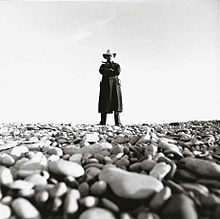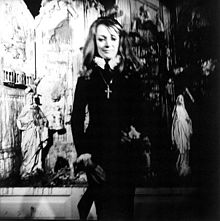Nouveau Réalisme

Nouveau Réalisme ( French for New Realism ) refers to a loose group of artists around the art critic Pierre Restany , which emerged as a programmatic movement in early 1960. The group initially chose Nice, where Yves Klein and Arman lived , as their base.
history
The first manifesto of this New Realism, Les Nouveaux Réalistes , was published in April 1960 in the catalog of a Milan group exhibition of French and Swiss artists at the Apollinaire gallery in Milan. Yves Klein and Pierre Restany, Arman (Armand Fernandez), François Dufrêne , an ultra- Lettrist , Raymond Hains , Martial Raysse , Daniel Spoerri , Jean Tinguely and Jacques de la Villeglé then signed this constitutive declaration on October 27, 1960 in Klein's apartment of a New Realism ( La Déclaration constitutive du Nouveau Realisme ) quite officially, it says: “The 'Nouveaux Réalistes' have become aware of their collective uniqueness. Nouveau Réalisme = new approach of the perceptual ability to the real. ”Nine copies of the manifesto (seven on blue, one each on pink and one on gold-colored paper) were signed.
Forty degrees above Dada , Au 40 ° (Quarante degrés) au dessus de Dada , the second manifesto, was also the title of the first exhibition at Galerie J by Jeannine Restany in May 1961 in Paris. Pierre Restany's text introduces the exhibition catalog. César (César Baldaccini) and Mimmo Rotella had joined the group, Gérard Deschamps and Niki de Saint Phalle will be added. Christo (Christo Jaracheff) took part in exhibitions, but was never an official member. In the fall of 1961, almost all members of the Nouveaux Réalistes took part in the exhibition The Art of Assemblage , which was organized by the Museum of Modern Art in New York and introduced the concept of assemblage in art history literature.
At the end of 1962, a major international exhibition of the New Realists, the International Exhibition of the New Realists , took place in New York. 54 artists presented works. The organizer was the Sidney Janis Gallery. Restany's people, along with Italians and English and a Swede, competed against the young American and some British Pop Art artists.
Restany's catalog entry was only printed in abbreviated form; Sidney Janis allegedly thought the Frenchman's statements were pointless. Restany's text for the second Festival of New Realism in Munich, New Realism. What is to be made of it? , Le Nouveau Réalisme. Que faut-il en penser? , in 1963 is considered the group's third and final manifesto. In 1970 the members celebrated their tenth and final anniversary in Milan with an exhibition, which ended with a “funeral banquet”; For this occasion, Spoerri created a presentation of his works for each member.
The work of the Nouveaux Réalistes
The members had set themselves the goal of breaking the lofty status of the fine arts and - turning away from abstract, informal art, which seemed too self-centered to them, and "petty bourgeois" realism - the reality of everyday life with new techniques and found materials to integrate into art. Following on from the early objets trouvés that arose in the context of Dadaism , they contributed significantly to the development of object art and the early forms of action art . With Pop Art she combined the criticism of mass culture and the advertising media whose products she used at the same time.
In the ugliness of the waste they saw the beauty of art. Dufrêne, Hains, Rotella and Villeglé, for example, acted as “poster tear-offs” by using the imagery of torn or pasted over billboards. Arman used the contents of paper baskets, Spoerri preserved bar tables that had been drained and tipped them vertically, Deschamps put rags and corsets together and presented clippings from truck tarpaulins like paintings. Tinguely built useless machines out of junk, César pressed car bodies into cubes, Klein as a loner with his monochrome panel paintings created pictures with flamethrowers and female bodies dyed in blue, Saint-Phalle shot tableaus covered with paint bags, so that the color gradients arose by chance. Even John Cladders with his poetry made of pasta letters of the movement was close.
Exhibitions (selection)
The group itself:
- 1960: May: Apollinaire Gallery, Milan
- 1961: June: Galerie J, Paris
- 1961: July: First New Realism Festival in Nice, the hometown of Klein and Arman. Rotella reading of phonetic poems
- 1961: The Art of Assemblage , Museum of Modern Art , New York. Participation by Arman, César, Dufrêne, Hains, Rotella, Villeglé, Tinguely and Spoerri
- 1962: November / December: Sidney Janis, New York City
- 1963: Munich: Second Festival of New Realism
- 1963: Fourth San Marino Biennale: Last group activity before the memorial exhibition in Milan.
- 1970: Milan: Les Nouveaux Réalistes 1960/1970 . Spoerri's mourning bouquet
Thematic exhibitions:
- 2001: Power of Things: Nouveau Réalisme, Pop Art, Hyperrealism , Museum Moderner Kunst Stiftung Ludwig Vienna
- 2007/08: Nouveau Réalisme - Revolution of the Everyday , Sprengel Museum , Hanover
- 2010: Nuevos Realismos: 1957–1962. Estrategias del objeto, entre readymade y espectáculo. Museo Nacional Centro de Arte Reina Sofía , Madrid
- 2015: poetry of the big city. The Affichists , Schirn Kunsthalle Frankfurt
See also
literature
- Jürgen Becker and Wolf Vostell (eds.): Happenings, Fluxus, Pop Art, Nouveau Réalisme . A documentation. Rowohlt Verlag, Reinbek 1965.
- Ulrich Krempel : Nouveau Réalisme. Revolution of the everyday , Hatje Cantz Verlag, Ostfildern 2007, ISBN 978-3-7757-2058-8 . Also as an exhibition catalog of the Sprengel Museum Hannover for the exhibition Revolution des everyday from September 9, 2007 to January 27, 2008, ISBN 978-3-89169-205-9
- Susanne Neuburger, Nouveau Réalisme , Museum Moderner Kunst Stiftung Ludwig Wien, Vienna 2005 ISBN 3-902490-12-8 (book trade edition : Verlag für moderne Kunst Nürnberg ISBN 3-938821-08-6 )
- Pierre Restany : Manifests des Nouveaux Réalistes. Éditions Dilecta, Paris 2007 (posthumous publication)
- Nuevos Realismos: 1957–1962. Estrategias del objeto, entre readymade y espectáculo. Museo Nacional Centro de Arte Reina Sofía, Madrid 2010, ISBN 978-84-8026-418-1 .
Web links
- Nouveau Réalisme, introductory text by the Center Pompidou (French)
- New Realism and the Affichists, an article by Marthe Lisson in Schirn Magazin (German)
Individual evidence
- ↑ Quoted from the Chronology of the Center Pompidou
- ↑ Uwe M. Schneede: The history of art in the 20th century: from the avant-garde to the present , CH Beck, Munich 2001, ISBN 3-406-48197-3 , p. 205
- ↑ nzz.ch, December 15, 2007 : Article about the exhibition by Peter Bürger : Everyday life and the “aesthetic baptism of the object” , accessed on November 20, 2010



